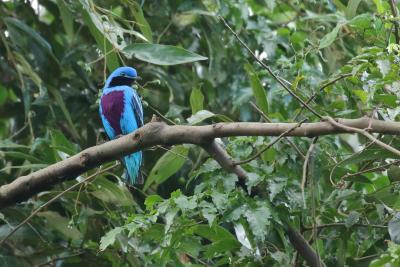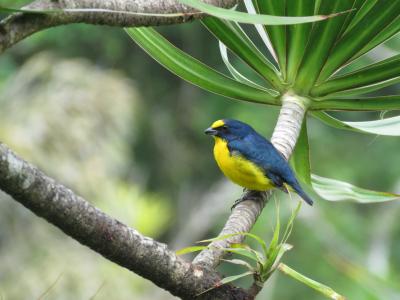2024 Narrative
In Brief: Our tour of Oaxaca and western Chiapas is designed to sample a variety of habitats across the isthmus and search for many of the specialty birds of the region. Beginning in Tuxtla Gutierrez, our birding ranged from the bamboo-choked woodland at Sumidero Canyon to the high-elevation pine-oak forests of San Cristobal to the humid rainforest at El Ocote, with birds like Red-breasted Chat, Pink-headed Warbler, and Keel-billed Toucan keeping us duly entertained. From Tuxtla, we descended to the Pacific slope, through gorgeous Rosita’s Buntings (and bonus Great Swallow-tailed Swifts!) to conspicuous Giant Wrens and Spot-breasted Orioles. Heading across the isthmus of Tehuantepec, habitats and birdlife changed dramatically. We appreciated amazing views of most of the Oaxaca specialties, including prolonged eye-level Dwarf Jay, confiding Oaxaca Sparrow, Ocellated Thrasher, skulking Slaty Vireo, Boucard’s Wrens and Bridled Sparrows…plus great food and no major logistical hiccups! It’s easy to see why this tour deserves its popularity. I’m excited for next time!
In Detail:
Day 1: Almost everyone arrived with time to settle in, do a little independent local birding around the hotel, and perhaps even jump in the pool to cool off before our intro meeting and first night dinner.
Day 2: Our early start to Sumidero Canyon really paid off, with great views of a flashy male Red-breasted Chat, along with a male Varied Bunting and an introductory foray into the world of Myiarchus flycatchers. Clear sunny skies meant that bird activity waned fairly early but we still enjoyed a good variety of birds, such as a glowing male Yellow Grosbeak, noisy Black-headed Saltators, a selection of taxonomically vexed vireos, plus scope views of some decidedly cryptic Singing Quail. ‘Non-feeder’ hummingbirds were also fun, of sometimes challenging, including a showy Plain-capped Starthroat, dazzling male Canivet’s Emerald, and handsome Azure-crowned Hummingbird (with azure crown seen, even if looked more like violet!) and Buff-bellied Hummingbird. After a fine picnic lunch and spectacular views of the canyon we headed back for a welcome siesta before an afternoon foray to the famous Tuxtla zoo. Here, normally shy birds like Great Curassow are easily seen strutting around, and we enjoyed a particularly good show from multiple Russet-crowned Motmots. In all, an excellent introductory day to birding in this part of the world.
Day 3: Wow, what an exceptional day around San Cristobal! We arrived at a reserve on the outskirts of town to the predicted cold (frost on the ground!) and quickly started racking up some pine-oak species. Right off the bat, we were shocked when our local guide Alberto showed us a roosting Bearded Screech-Owl…a total bonus! Climbing higher uphill, we enjoyed mixed warbler flocks as the sun hit the hillsides, with Crescent-chested, Hermit, Townsend’s, Red-faced, Golden-cheeked (!), and eventually the much-desired Pink-headed Warbler! Supporting cast included Rufous-collared Thrush, Garnet-throated Hummingbirds (delightfully common this year), Strong-billed Woodcreeper (the Central American one, sounding very different from Sclater’s which we saw later in Oaxaca), Unicolored Jay, Black-capped Swallow, and even a Guatemalan Pygmy-Owl. After a great lunch in town, we continued to a different spot, rounding out our excellent haul of highland species with a very cooperative Blue-throated Motmot.
Day 4: Another morning at Sumidero Canyon, this time starting a little higher up and working our way to the farthest overlook. We focused on Belted Flycatcher, which seems to be getting more difficult to find, and most of the group eventually connected with brief obstructed views. Much more obliging was a Flammulated Flycatcher that seemed desperate to be seen, plus plenty of other bits and pieces…a young male Red-breasted Chat was much appreciated, and we sorted through mixed flocks with Blue-headed and Gray-headed (Central American “Plumbeous”) Vireos, and Black-throated Green, Black-and-white, and Magnolia Warblers. And in the big-colorful-birds department, we had great views of Gartered Trogon and Lesson’s Motmot! After a picnic lunch followed by a siesta at the hotel, we headed out to El Ocote in the afternoon, with Nava’s Wren on our minds. Unfortunately, with increased pressure from birders and playback, this species seems to be getting harder and harder to see. We certainly heard it (loud and close!) but never caught a glimpse. It is a spectacular song!
Day 5: We departed from Tuxtla the next morning and headed to our next base, Arriaga, via some morning birding again at El Ocote. Conditions were difficult with dense fog, but we practiced birding-by-ear as we walked down the road, with a “heard of wrens” keeping us busy (Spot-breasted, White-bellied, Cabanis’s, House, and White-breasted Wood-Wrens all heard). A perched Long-billed Starthroat was quite nice, and we pieced together plenty of other nice birds including Collared Trogon, White-crowned Parrot, Masked and Black-crowned Tityra, and Keel-billed Toucan.
We made it to Arriaga for lunch and a siesta, followed by some birding up in the foothills. We were pleasantly surprised with Great Swallow-tailed Swift at the overlook, plus a ton of migrating Western Kingbirds, Scissor-tailed Flycatchers, and even Red-legged Honeycreeper seemingly traveling with the Western Tanager flocks. Further downslope we enjoyed great views of Green-fronted Hummingbird and White-lored Gnatcatcher before finally connecting with the sought-after Rosita’s Bunting, one of the best birds of the tour! Initial quick glimpses were upstaged when a male decided to perch only a few meters away and quietly sing his head off. Absolutely stunning!
Day 6-7: The next two days saw us birding in the coastal lowlands around Puerto Arista and El Paredon, which held a whole new suite of birds. Our list was padded with lots of waterbirds: Magnificent Frigatebirds circled overhead, Wood Storks and White Ibis flew by, Green and Ringed Kingfishers hunted over the river, and Reddish Egrets fed in the shallows. The main target in this area, however, is the impressive Giant Wren, which proved quite easy and cooperative! There were almost too many birds to look at in addition to the wrens, with migrating Western Kingbirds, Scissor-tailed Flycatchers, and Orchard Orioles overhead, Spot-breasted and Altamira Orioles in the flowering trees, Common Black-Hawks putting on a show, Yellow-naped Parrot perched up nicely, funky Yellow-winged (Mexican) Caciques, and the local White-bellied Chachalaca. We even connected with the should-be-split Salvadoran (or Ridgway’s) Flycatcher, which sounds completely different from the other Nutting’s. Another brief foray into the foothills in the afternoon gave us even more Great Swallow-tailed Swifts (vocalizing and courting!) plus eye-level Grace’s and Yellow-throated Warblers.
A long afternoon drive brought us to Tehuantepec, where we enjoyed an evening of owling in the dry thorn scrub. A quick stop at the river in town was productive for waterbirds (Blue-winged Teal, Northern Shoveler, Redhead, and Lesser Scaup padded our duck list, plus lots of American Coot, Common Gallinule, Least Grebe, and a couple Osprey, among other things!) Upon arrival, it was a relief to see Cinnamon-tailed (Sumichrast’s) Sparrow extremely well in the evening to save us some pressure the next morning. An evening highlight was a Collared Forest-Falcon that nearly took our heads off, and Mottled Owl posed nicely if briefly after dark.
Day 8: Today was mostly a travel day, making the long drive from the isthmus to the Oaxaca Valley. Some early morning birding on the Guiengola Road produced the recently-split (officially) Turquoise-crowned (Doubleday’s) Hummingbird and finally a stunning male Orange-breasted Bunting! On into the hills, we made another stop which was good for several Plain-capped Starthroats, more Turquoise-crowned Hummingbirds and Orange-breasted Buntings, Ash-throated and Nutting’s Flycatcher, and even a Lesser Ground-Cuckoo that ran across the track! Finally into the real Oaxaca Valley, where lunch at Rancho Zapata gave us our first taste of the new suite of birds: Boucard’s Wrens bouncing around while we ate lunch, Gray-breasted Woodpeckers noisily flying around the cactus, Curve-billed Thrashers running around the gardens. We made it to our hotel with some time to rest and gear up for the next three days of birding.
Day 9: The road up Cerro San Felipe was our first port of call, starting in the oak scrub and ending in cool pine forests at over 9,000 feet. As the sun hit the lower slopes, the birds came fast and furious…a whole tree full of Gray Silkies with a pair of Elegant Euphonias! Roadside Oaxaca Sparrows scratching with White-throated Towhees! Black-vented Orioles in the flowering tree! Blue Mockingbird singing in the open! Wow…there were new birds everywhere. We made it off the main highway and even connected with a singing Ocellated Thrasher and a skulking Slaty Vireo nearby. From here we moved higher into the cool pine forest, where we stopped the van precisely where a flock of Gray-barred Wrens and…Dwarf Jays were calling! Amazingly, the jays foraged at eye-level for at least fifteen minutes and even bathed briefly in a stream below us, giving us incredible views at this increasingly difficult species. Of course, our first Red Warblers were duly savored, followed by more great highland birding…warbler flocks, Sclater’s (Strong-billed) Woodcreeper, Collared Towhee and Rufous-capped Brushfinch and Blue-throated Mountain-gem at our lunch spot, and very confiding Red Crossbills and Mountain Trogon in the afternoon.
Day 10: This morning was spent at lower elevations, starting at Yagul with Cassin’s Kingbird, Loggerhead Shrike, Blue Grosbeak, more Boucard’s Wrens, Curve-billed Thrashers, and several good views of quite a few Beautiful Hummingbirds! It took a while but we eventually tracked down the stunning Bridled Sparrow (perhaps my favorite sparrow in Mexico) which sat up nicely on some cactus below eye-level. We then explored a nearby reservoir with surprise West Mexican Chachalacas sitting still in the roadside thickets, our first Black Phoebe, and a nice bunch of migrants including Hermit Warbler and a flock of Chipping Sparrows. After a drive-by of the Tule tree (the stoutest tree in the world!) and a nice lunch at Palapa de Raul, we ventured up yet again into the pine forests for a picnic dinner and some owling. Conditions were pretty good and we started out with several Mexican Whip-poor-wills singing as dusk fell, but the main highlight was certainly the Fulvous Owl that came in (after significant effort). Great, repeated views were enjoyed by all.
Day 11: Our final day was spent north of Oaxaca city, starting on a quiet road through oak scrub and continuing to another long road up into the pines and oaks. At first, things were incredibly quiet…the quickest of glimpses of Dwarf Vireo were hardly satisfying, but it was quite nice to connect with Red-headed Tanager on our way back to the van! We then worked our way upslope, where the blazing sun didn’t help, but we managed to pull in some nice mixed flocks of warblers and various other passerines (Crescent-chested, Hermit, Townsend’s, Red, and Red-faced Warblers, Hutton’s and Plumbeous Vireos, Ruby-crowned Kinglets, Hammond’s Flycatcher). A clear highlight was the wonderful Lesser Roadrunner that Nick spotted hunting at the edge of a dry pond. We savored this for a while before heading into the shady pines for a picnic lunch, and for a grand finale, connected with a stunning Chestnut-sided Shrike-Vireo…certainly one of the best vireos in the world, and this one sat still for fifteen minutes while we watched in the scope! An awesome way to wrap up the tour!
All too soon, it was time to head back to the hotel for a final delicious dinner (mmm, mole). Thank you, everyone, for such a wonderful tour full of great birds, food, scenery, and camaraderie! Until next time…
- Luke Seitz
Back to Narratives














































